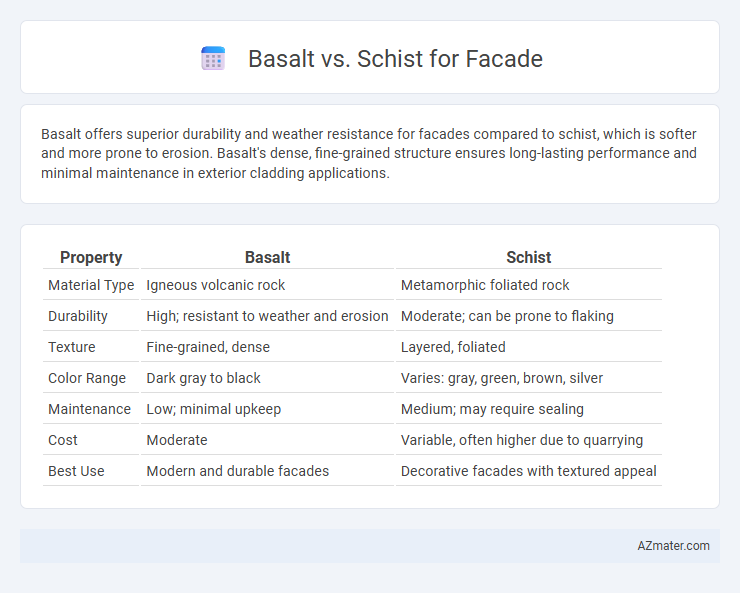Basalt offers superior durability and weather resistance for facades compared to schist, which is softer and more prone to erosion. Basalt's dense, fine-grained structure ensures long-lasting performance and minimal maintenance in exterior cladding applications.
Table of Comparison
| Property | Basalt | Schist |
|---|---|---|
| Material Type | Igneous volcanic rock | Metamorphic foliated rock |
| Durability | High; resistant to weather and erosion | Moderate; can be prone to flaking |
| Texture | Fine-grained, dense | Layered, foliated |
| Color Range | Dark gray to black | Varies: gray, green, brown, silver |
| Maintenance | Low; minimal upkeep | Medium; may require sealing |
| Cost | Moderate | Variable, often higher due to quarrying |
| Best Use | Modern and durable facades | Decorative facades with textured appeal |
Introduction to Basalt and Schist as Facade Materials
Basalt is a dense, volcanic igneous rock known for its durability, weather resistance, and dark, uniform appearance, making it an excellent choice for modern facade applications. Schist, a metamorphic rock characterized by its pronounced foliation and varied mineral composition, offers unique texture and natural patterns, contributing to an aesthetically rich exterior surface. Both materials provide long-lasting facade solutions, with basalt emphasizing structural strength and schist highlighting distinctive visual appeal.
Geological Formation and Characteristics
Basalt, an igneous rock formed from rapid cooling of lava, is characterized by its fine-grained texture, high density, and exceptional durability, making it resistant to weathering and ideal for facade cladding. Schist, a metamorphic rock originating from regional metamorphism of shale, exhibits pronounced foliation and a layered structure composed mainly of mica minerals, which can affect its mechanical strength and weather resistance in exterior applications. The geological formation of basalt results in a homogeneous, hard surface, while schist's foliated texture may lead to varying performance in facade durability and maintenance.
Aesthetic Appeal: Color and Texture Differences
Basalt offers a sleek, dark gray to black color with a fine-grained, uniform texture that creates a modern, minimalist facade aesthetic. Schist features a layered, foliated texture with a range of earthy tones such as silver, green, or brown, providing a more natural, rustic appearance. The choice between basalt and schist for facades hinges on the desired visual impact: basalt for clean, contemporary lines and schist for textured, organic character.
Strength and Durability Comparison
Basalt exhibits superior strength and durability compared to schist, making it an ideal choice for facade applications requiring long-term resistance to weathering and mechanical stress. Basalt's fine-grained, dense igneous structure provides enhanced compressive strength and low porosity, minimizing water absorption and reducing the risk of freeze-thaw damage. Schist, while aesthetically appealing due to its foliated texture, generally has lower strength and higher susceptibility to delamination and erosion under harsh environmental conditions.
Weather Resistance and Maintenance Needs
Basalt offers superior weather resistance for facades due to its dense, fine-grained volcanic composition, making it highly resistant to moisture, freeze-thaw cycles, and abrasion. Schist, characterized by its foliated texture and variable mineral content, tends to be more susceptible to weathering and may require more frequent sealing and maintenance to prevent water infiltration and surface degradation. Maintenance needs for basalt facades are minimal compared to schist, which demands regular inspections and treatments to preserve its structural integrity and aesthetic appeal under varying climatic conditions.
Thermal Performance and Insulation Properties
Basalt offers superior thermal performance for facades due to its high density and low thermal conductivity, providing excellent insulation and reducing heat transfer effectively. Schist, with its foliated structure, has higher thermal conductivity, resulting in less insulation efficiency compared to basalt. Choosing basalt for cladding enhances energy efficiency by maintaining indoor temperature stability and lowering HVAC energy consumption.
Environmental Impact and Sustainability
Basalt is a volcanic rock known for its durability and low environmental impact due to its natural abundance and minimal processing requirements, making it a sustainable choice for facades. Schist, a metamorphic rock with foliated texture, often requires more intensive quarrying and processing, which increases its carbon footprint compared to basalt. Both materials offer longevity, but basalt's lower embodied energy and recyclability give it an edge in sustainable facade applications.
Installation Methods and Construction Considerations
Basalt cladding requires precise cutting due to its hardness and weight, necessitating strong anchoring systems like stainless steel brackets or mechanical fixings to ensure stability and durability in facade installation. Schist, being softer and more foliated, allows for easier shaping and faster installation but demands careful moisture management and proper waterproofing to prevent weathering and delamination. Construction considerations for basalt emphasize load-bearing capacity and long-term wear resistance, while schist installations focus on flexibility in design and maintenance protocols to maintain structural integrity and aesthetic appeal.
Cost Analysis: Basalt vs Schist Facades
Basalt facades typically cost more upfront due to their density, durability, and extraction complexity, with prices averaging $50 to $100 per square foot, while schist offers a more affordable option at $30 to $70 per square foot, influenced by local quarry availability. Basalt's longer lifespan and lower maintenance expenses can result in better long-term value despite higher initial investment compared to schist, which may require more frequent upkeep due to its foliated structure. Choosing between basalt and schist for facades involves balancing initial cost with durability, where basalt outperforms in resilience but schist provides budget-friendly aesthetic appeal.
Best Applications and Architectural Examples
Basalt offers superior durability and weather resistance, making it ideal for facades exposed to harsh climates and urban pollution, as seen in the exterior of the Biblioteca Nacional de Espana. Schist provides excellent natural texture and aesthetic appeal, suitable for decorative facades and interior cladding, exemplified by the rugged stone finishes of the VitraHaus in Germany. Both materials enhance thermal insulation and longevity, with basalt preferred for structural robustness and schist for its unique layered appearance in contemporary architectural designs.

Infographic: Basalt vs Schist for Facade
 azmater.com
azmater.com